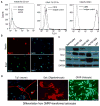Rapid Reprogramming of Primary Human Astrocytes into Potent Tumor-Initiating Cells with Defined Genetic Factors
- PMID: 27364552
- PMCID: PMC5082736
- DOI: 10.1158/0008-5472.CAN-16-0171
Rapid Reprogramming of Primary Human Astrocytes into Potent Tumor-Initiating Cells with Defined Genetic Factors
Abstract
Cancer stem-like cells (CSC) are thought to drive brain cancer, but their cellular and molecular origins remain uncertain. Here, we report the successful generation of induced CSC (iCSC) from primary human astrocytes through the expression of defined genetic factors. Combined transduction of four factors, Myc, Oct-4, p53DD, and Ras, induced efficient transformation of primary human astrocytes into malignant cells with powerful tumor-initiating capabilities. Notably, transplantation of 100 transduced cells into nude mice was sufficient for tumor formation. The cells showed unlimited self-renewal ability with robust telomerase activities. In addition, they expressed typical glioma stem-like cell markers, such as CD133, CD15, and CD90. Moreover, these cells could form spheres in culture and differentiate into neuron-like, astrocyte-like, and oligodendrocyte-like cells. Finally, they also displayed resistance to the widely used brain cancer drug temozolomide. These iCSCs could provide important tools for studies of glioma biology and therapeutics development. Cancer Res; 76(17); 5143-50. ©2016 AACR.
©2016 American Association for Cancer Research.
Conflict of interest statement
The authors declare no financial interest in the work described in this study.
Figures





Similar articles
-
Reprogramming of retinoblastoma cancer cells into cancer stem cells.Biochem Biophys Res Commun. 2017 Jan 22;482(4):549-555. doi: 10.1016/j.bbrc.2016.11.072. Epub 2016 Nov 14. Biochem Biophys Res Commun. 2017. PMID: 27856246
-
Knock out CD44 in reprogrammed liver cancer cell C3A increases CSCs stemness and promotes differentiation.Oncotarget. 2015 Dec 29;6(42):44452-65. doi: 10.18632/oncotarget.6090. Oncotarget. 2015. PMID: 26540347 Free PMC article.
-
Dedifferentiation of patient-derived glioblastoma multiforme cell lines results in a cancer stem cell-like state with mitogen-independent growth.J Cell Mol Med. 2015 Jun;19(6):1262-72. doi: 10.1111/jcmm.12479. Epub 2015 Mar 19. J Cell Mol Med. 2015. PMID: 25787115 Free PMC article.
-
Generation of induced cardiac progenitor cells via somatic reprogramming.Oncotarget. 2017 Apr 25;8(17):29442-29457. doi: 10.18632/oncotarget.15272. Oncotarget. 2017. PMID: 28199972 Free PMC article. Review.
-
Defined human cellular systems in the study of glioma development.Front Biosci. 2003 Jan 1;8:s19-27. doi: 10.2741/983. Front Biosci. 2003. PMID: 12456369 Review.
Cited by
-
A PRMT5-RNF168-SMURF2 Axis Controls H2AX Proteostasis.Cell Rep. 2019 Sep 17;28(12):3199-3211.e5. doi: 10.1016/j.celrep.2019.08.031. Cell Rep. 2019. PMID: 31533041 Free PMC article.
-
Non-canonical roles of apoptotic and DNA double-strand break repair factors in mediating cellular response to ionizing radiation.Int J Radiat Biol. 2023;99(6):915-924. doi: 10.1080/09553002.2021.1948139. Epub 2021 Jul 14. Int J Radiat Biol. 2023. PMID: 34187285 Free PMC article. Review.
-
Inhibition of hypoxic exosomal miR-423-3p decreases glioma progression by restricting autophagy in astrocytes.Cell Death Dis. 2025 Apr 8;16(1):265. doi: 10.1038/s41419-025-07576-2. Cell Death Dis. 2025. PMID: 40199864 Free PMC article.
-
Overcoming therapeutic resistance in glioblastoma: the way forward.J Clin Invest. 2017 Feb 1;127(2):415-426. doi: 10.1172/JCI89587. Epub 2017 Feb 1. J Clin Invest. 2017. PMID: 28145904 Free PMC article. Review.
-
The complex interactions between the cellular and non-cellular components of the brain tumor microenvironmental landscape and their therapeutic implications.Front Oncol. 2022 Oct 6;12:1005069. doi: 10.3389/fonc.2022.1005069. eCollection 2022. Front Oncol. 2022. PMID: 36276147 Free PMC article. Review.
References
-
- Bonnet D, Dick JE. Human acute myeloid leukemia is organized as a hierarchy that originates from a primitive hematopoietic cell. Nat Med. 1997;3:730–7. - PubMed
-
- Singh SK, Hawkins C, Clarke ID, Squire JA, Bayani J, Hide T, et al. Identification of human brain tumour initiating cells. Nature. 2004;432:396–401. - PubMed
Publication types
MeSH terms
Grants and funding
LinkOut - more resources
Full Text Sources
Other Literature Sources
Research Materials

